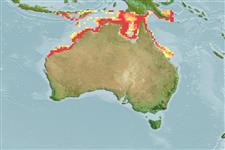Élasmobranches (requins et raies) (sharks and rays) >
Orectolobiformes (Carpet sharks) >
Hemiscylliidae (Bamboo sharks)
Etymology: Hemiscyllium: hemi-, from hemisys (Gr.), half, presumably referring to similarity and/ or close affinity to Scyllium (=Scyliorhinus, now in Scyliorhinidae) and/or Chiloscyllium; skylion, Greek for dogfish or small shark. (See ETYFish); trispeculare: tri-, from tres (L.), three; specularis (L.), watchful or looking, referring to three eyespots (ocelli) on shoulder. (See ETYFish).
More on author: Richardson.
Environment: milieu / climate zone / depth range / distribution range
Écologie
marin récifal; profondeur 0 - 50 m (Ref. 54542). Tropical; 8°S - 22°S, 114°E - 152°E (Ref. 54542)
Western Pacific: northern Australia (including Western Australia) (Ref. 6871). Possibly in the Mollucas (Indonesia).
Length at first maturity / Taille / Poids / Âge
Maturity: Lm ?, range 53 - ? cm
Max length : 79.0 cm TL mâle / non sexé; (Ref. 43278)
Épines dorsales (Total) : 0; Épines anales: 0. Body covered with numerous, densely clustered dark, small and large spots that form a reticular network of light ground color between them; dark crossbands strong on ventral surface of tail (Ref. 13575).
Found on shallow coral reefs of the continental shelf (Ref. 247). Probably mainly feeding on benthic invertebrates (Ref. 6871). Oviparous (Ref. 50449).
Life cycle and mating behavior
Maturities | Reproduction | Spawnings | Egg(s) | Fecundities | Larves
Oviparous, paired eggs are laid. Embryos feed solely on yolk (Ref. 50449).
Compagno, L.J.V., 1984. FAO Species Catalogue. Vol. 4. Sharks of the world. An annotated and illustrated catalogue of shark species known to date. Part 1 - Hexanchiformes to Lamniformes. FAO Fish. Synop. 125(4/1):1-249. Rome, FAO. (Ref. 247)
Statut dans la liste rouge de l'IUCN (Ref. 130435)
Utilisations par l'homme
Pêcheries: intérêt commercial mineur
Outils
Articles particuliers
Télécharger en XML
Sources Internet
Estimates based on models
Preferred temperature (Ref.
123201): 26.9 - 28.7, mean 27.9 °C (based on 210 cells).
Phylogenetic diversity index (Ref.
82804): PD
50 = 0.5020 [Uniqueness, from 0.5 = low to 2.0 = high].
Bayesian length-weight: a=0.00407 (0.00181 - 0.00918), b=3.09 (2.89 - 3.29), in cm total length, based on LWR estimates for this (Sub)family-body shape (Ref.
93245).
Niveau trophique (Ref.
69278): 3.5 ±0.37 se; based on food items.
Résilience (Ref.
120179): Faible, temps minimum de doublement de population : 4,5 à 14 années (Fec assumed to be <100).
Fishing Vulnerability (Ref.
59153): Moderate to high vulnerability (52 of 100).
Nutrients (Ref.
124155): Calcium = 16.1 [3.1, 60.5] mg/100g; Iron = 0.407 [0.100, 1.103] mg/100g; Protein = 19.3 [17.1, 21.3] %; Omega3 = 0.0839 [, ] g/100g; Selenium = 28.1 [8.7, 78.1] μg/100g; VitaminA = 56.1 [19.8, 149.3] μg/100g; Zinc = 0.984 [0.482, 2.033] mg/100g (wet weight);
